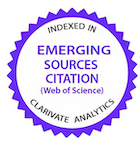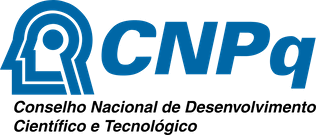Utrofina, MHC e macrófagos M1 e M2 em cães DMGR
DOI:
https://doi.org/10.1590/1809-6891v21e-52383Resumo
As distrofias musculares são doenças hereditárias que levam à degeneração progressiva da musculatura esquelética. Cães Golden Retriever são usados como modelos animais, pois desenvolvem uma doença muscular hereditária semelhante à distrofia muscular em humanos. Objetivos: Avaliar a imunomarcação dos macrófagos M1 (CD68) e M2 (CD163), MHC I, MHC II e utrofina nos músculos de cães Golden Retriever afetados pela distrofia muscular (DMGR). Métodos: Amostras de 17 cães machos afetados por DMGR foram divididas em cães distróficos GI - até um ano de idade; e GII - cães distróficos com mais de um ano de idade. Resultados: a imunomarcação de CD163 foi maior que CD68 nos grupos GI e GII. CD68 não mostrou variação entre os grupos de animais distróficos. A imunomarcação de MHC classe I foi mais evidente no bíceps femoral e tríceps braquial. O MHC classe II foi expresso discretamente nos quatro tipos de músculo distrófico no GI e GII. A imunomarcação de utrofina foi maior no GII. Conclusão: Os macrófagos M2 foram uma das principais células inflamatórias mononucleares encontradas nos músculos distróficos. O número de M2 nos músculos de cães com DMGR aumentou com a idade, ligando esse subtipo de célula a danos musculares permanentes.
Palavras-chave: Distrofia Muscular do Golden Retriever (DMGR); imuno-histoquímica; inflamação; miopatia; músculo.
Downloads
Referências
Kornegay JN, Bogan JR, Bogan DJ, Childers MK, Li J, Nghiem P, et al. Canine models of Duchenne muscular dystrophy and their use in therapeutic strategies. Mammalian Genome. 2012; 23 (1-2): 85-108.
Kornegay JN. The golden retriever model of Duchenne muscular dystrophy. Skeletal Muscle. 2017;7(1):9.
Barthelemy I, Pinto-Mariz F, Yada E, Desquilbet L, Savino W, Silva-Barbosa SD, Faussat AM, Mouly V, Voit T, Blot S, et al. Predictive markers of clinical outcome in the GRMD dog model of Duchenne muscular dystrophy. Disease Models and Mechanisms. 2014; 7 (11): 1253-1261.
Miyazato LG, Beretta DC, Engracia Filho JR, Moraes FR, Moraes JRE. Evaluation of intracellular calcium in canine muscular dystrophy. Brazilian Journal of Veterinary Pathology. 2011a; 4 (2): 95-102.
Miyazato LG, Beretta DC, Engracia Filho JR, Moraes FR, Moraes JRE. Involvement of Organic Systems in Golden Retriever X-linked Muscular Dystrophy. Brazilian Journal of Veterinary Pathology. 2011b; 4 (2): 87-94.
Beretta DC, Moraes JRE; Engracia Filho JR, Malvestio LMM, Moraes FR. Immunohistochemical and morphometric evaluation of gastrocnemius muscle and myotendinous junction of golden retriever dogs with muscular dystrophy. Brazilian Journal of Veterinary Pathology. 2014; 7 (2): 70-81.
Shim JY; Kim, TS. Relationship between utrophin and regenerating muscle fibers in Duchenne muscular dystrophy. Yonsei Medical Journal. 2003; 44 (1): 15-23.
St Pierre BA, Tidball JG. Differential response of macrophage subpopulations to soleus muscle reloading after rat hind limb suspension. Journal of Applied Physiology. 1994; 77 (1): 290-297.
Tidball JG, Wehling-Henricks M. Macrophages promote muscle membrane repair and muscle fiber growth and regeneration during modified muscle loading in mice in vivo. Journal of Physiology, Chichester, v. 578, p. 327-336, 2007.
Wehling-Henricks M, Sokolow S, Lee JJ, Myung KH, Villalta SA, Tidball JG. Major basic protein-1 promotes fibrosis of dystrophic muscle and attenuates the cellular immune response in muscular dystrophy. Human Molecular and Genetics. 2008; 1; 17 (15): 2280-2292.
Arnold L, Henry A, Poron F, Baba-Amer Y, Rooijen NV, Plonquet A, Gherardi RK, Chazaud B. Inflammatory monocytes recruited after skeletal muscle injury switch into antiinflammatory macrophages to support myogenesis. Journal of Experimental Medicine. 2007; 204 (5): 1057-1069.
Villalta SA, Nguyen HX, Deng B, Gotoh T, Tidball JG. Shifts in macrophage phenotypes and macrophage competition for arginine metabolism affect the severity of muscle pathology in muscular dystrophy. Hum Mol Genet 2009; 18: 482-496.
Villalta SA, Deng B, Rinaldi C, Wehling-Henricks M, Tidball JG. IFN-γ promotes muscle damage in the mdx mouse model of Duchenne muscular dystrophy by suppressing M2 macrophage activation and inhibiting muscle cell proliferation. Journal of Immunology. 2011a; 187: (10) 5419-5428.
Harris HW, Gill TJ. Expression of Class I Transplantation Antigens. Transplantation. 1989; 42 (2): 109-117.
Ponder BA, Wilkinson MM, Wood M, Westwood JH. Immunohistochemical demonstration of H2 antigens in mouse tissue sections. Journal of Histochemistry & Cytochemistry. 1983; 31(7): 911-919.
McDouall RM, Dunn MJ, Dubowitz V. Expression of class I and class II MHC antigens in neuromuscular diseases. Journal of Neurological Sciences. 1989; 89 (2-3): 213-226.
Spencer MJ, Tidball JG. Do immune cells promote the pathology of dystrophin-deficient myopathies? Neuromuscular Disorders. 2001; 11 (6-7): 556-564.
Kornegay 1988. Kornegay JN, Tuler SM, Miller DM, Levesque DC. Muscular dystrophy in a litter of golden retriever dogs. Muscle & Nerve, v. 11, n. 10, p. 1056-1064, 1988.
Valentine BA, Cooper BJ. Canine X-linked muscular dystrophy: selective involvement of muscles in neonatal dogs. Neuromuscul Disord. 1991;1(1):31-8.
Nguyen F, Cherel Y, Guigand L, Goulbault-Leroux I, Wyers M. Muscle lesions associated with dystrophin deficiency in neonatal Golden Retriever puppies. Journal of Comparative Pathology, v. 126, n. 2-3, p. 100-108, 2002.
Toledo, GN, Moraes, JRE. Histopathological evaluation of Golden Retriever dogs with progressive muscular dystrophy. Investigação. 5(9):29-34, 2016.
Hsu SM, Rainer L, Fanger HA. A comparative study of the peroxidase anti peroxidase method and an avidin-biotin complex method for studying polypeptide hormones with radioimmunoassay antibodies. American Journal of Clinical Pathology. 1981; 75 (5): 734-738.
Blake DJ, Weir A, Newey SE, Davies KE. Function and genetics of dystrophin and dystrophin related proteins in muscle. Physiological Reviews. 2002; 82 (2): 291-329.
Desguerre I, Mayer M, Leturcq F, Patrick Barbet J, Gherardi RK, Christov CL. Endomysial fibrosis in Duchenne muscular dystrophy: a marker of poor outcome associated with macrophage alternative activation. Journal of Neurop1athology and Experimental Neurology. 2009; 68 (7): 762-763.
Falini B, Flenghi L, Pileri S, Gambacorta M, Bigerna B, Durkop H, Eitelbach F, Thiele J, Picini R, Cavalieri A. PG-M1: a new monoclonal antibody directed against a fixative resistant epitope on the macrophage-restricted form of the CD68 molecule. The American Journal of Pathology. 1993; 142 (5): 1359-1372.
Gaiad TP, Araujo KPC, Serão JC. 2014. Motor Physical Therapy Affects Muscle Collagen Type I and Decreases Gait Speed in Dystrophin-Deficient Dogs. PLoS One. 9(4):1-9.
Wehling-Henricks M, Tidball JG. Neuronal nitric oxide synthase-rescue of dystrophin/utrophin double knockout mice does not require nNOS localization to the cell membrane. PLoS ONE. 2011; 6, (10).
Wehling M., Spencer M.J., Tidball J.G. A nitric oxide synthase transgene ameliorates muscular dystrophy in mdx mice. Journal of Cell Biology. 2001; (155):123-131
Villalta SA, Rinaldi C, Deng B, Liu G, Fedor B, Tidball JG. Interleukin-10 reduces the pathology of mdx muscular dystrophy by deactivating M1 macrophages and modulating macrophage phenotype. Human Molecular Genetics. 2011b; 20 (4): 790-805.
Partridge ACT, Bou-Garcia G. Implication of the satellite cell in dystrophic muscle fibrosis: a self-perpetuating mechanism of collagen overproduction. American Journal of Physiology. Cell Physiology. 2007; 293 (2): 661-669.
Sifringer M, Uhlenberg B, Lammel S. Identification of transcripts from a subtraction library which might be responsible for the mild phenotype in an intrafamilially variable course of Duchenne muscular dystrophy. Human Genetics. 2004; 114 (2): 149-156.
Tidball JG, Wehling-Henricks M. Evolving therapeutic strategies for Duchenne muscular dystrophy: targeting downstream events. Pediatric Research. 2004; 56 (6): 831-841
Tidball JG, Wehling-Henricks M. Macrophages promote muscle membrane repair and muscle fiber growth and regeneration during modified muscle loading in mice in vivo. The Journal of Physiology. 2007; 578 (Pt 1): 327-336.
Miyazato LG, Moraes JRE, Beretta DC, Kornegay JN. Muscular dystrophy in dogs: does the crossing of breeds influence disease phenotype? Veterinary Pathology. 2011c; 48 (3): 655 - 662.
Nagaraju K. Role of major histocompatibility complex class I molecules in autoimmune myositis. Current Opinion in Rheumatology. 2005; 17(6): 725-730.
Downloads
Publicado
Como Citar
Edição
Seção
Licença
Copyright (c) 2020 Ciência Animal Brasileira

Este trabalho está licenciado sob uma licença Creative Commons Attribution 4.0 International License.
Autores que publicam nesta revista concordam com os seguintes termos:
- Autores mantém os direitos autorais e concedem à revista o direito de primeira publicação, com o trabalho simultaneamente licenciado sob a Licença Creative Commons Attribution que permite o compartilhamento do trabalho com reconhecimento da autoria e publicação inicial nesta revista.
- Autores têm autorização para assumir contratos adicionais separadamente, para distribuição não-exclusiva da versão do trabalho publicada nesta revista (ex.: publicar em repositório institucional ou como capítulo de livro), com reconhecimento de autoria e publicação inicial nesta revista.
- Autores têm permissão e são estimulados a publicar e distribuir seu trabalho online (ex.: em repositórios institucionais ou na sua página pessoal) a qualquer ponto antes ou durante o processo editorial, já que isso pode gerar alterações produtivas, bem como aumentar o impacto e a citação do trabalho publicado (Veja O Efeito do Acesso Livre).






























